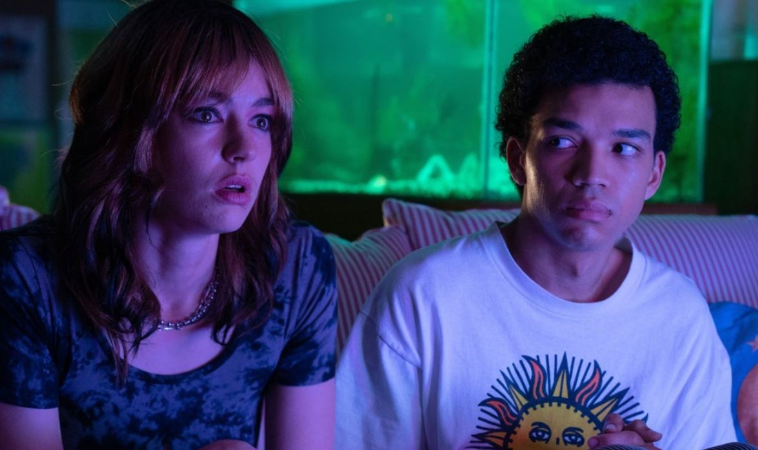I Saw The TV Glow
Films & TV
“Whilst acknowledging that I Saw the TV Glow is not for everyone’s tastes, I left entranced and have been pondering the experience for weeks,” says Jonathan Sargeant from FormED Faith

You’ve probably heard people say, “That person is happy in their skin”. To an extent most of us don’t worry about applying that to ourselves because we DO feel happy or at least are unaware of non-happiness. Our skin feels natural. But this feeling is not true for everyone. For some people the sense of un-ease with their skin is palpable to the point of pain. I Saw The TV Glow is a film that explores this agony with a nerve-shredding accuracy, making it one of the stand-out cinematic releases of the year to date.
1996 sees Owen (Justice Smith) dealing with high school as an isolated seventh-grade loner, adrift from the concerns of the students around him. That is until he meets Maddy (Brigette Lundy-Paine), a slightly older student, reading an episode guide for the TV show, The Pink Opaque. The two develop a special bond around their shared love of the quirky show that features a pair of super-powered demon-hunting teens. There is no romance, but there is intimacy of feeling. Screenwriter and director Jane Schoenbrun accurately depicts the feel of the relationship between the two — it is about moments of shared perspective as much as it is the many silences in between. The unsaid sentiments that live in orbit around each sentence make the spoken words more profound. Maddy is ostracised at school because of her sexuality. When asked about his own sense of self, Owen is unsure, apart from knowing that “something is wrong”.
Traversing two more time periods in the duo’s lives, Schoenbrun’s sparse, yet incisive, script explores that sense of dread common to many adolescents and young adults. She zeroes in on the notion that in cultures where the eroded foundations of faith have been effortlessly replaced by niche media content, the deepest relationships can form through common experiences of television. The way the in-film phenomenon of The Pink Opaque — a Buffy the Vampire Slayer analogue in all but name —gives Owen and Maddy an external maelstrom-like refuge that survives life’s other inflictions is genius.
Advertisement
TV Glow’s general 90’s aesthetic is gorgeous to look at, drenched in neons and stark arc-lit sets. The recreation of that time is razor-sharp, and the cinematography is outrageously literate in copying the feel of 90’s horror-tinged teen films. Through it all that sense of dread emerges as the unifying locus. For Owen, something is just not right. Something is “off”. Whilst there are clues as to what that is, it was not until I read more about the intriguing film that some of the pieces fell into place.
Schoenbrun and her cast talk about the film as being an allegory of the experiences of transgender teenagers. The term “transgender” is not mentioned in the film; however, being offered this interpretive lens, the film’s puzzle-like narrative provides “A-ha!” moments that elevate it wonderfully. Schoenbrun, themselves a transgender woman, pointed to this in a profile in the June 2024 New Yorker magazine, stating:
“TV Glow is about something I think a lot of trans people understand…The tension between the space that you exist within, which feels like home, and the simultaneous terror and liberation of understanding that that space might not be able to hold you in your true form. I think many people, even if they are sympathetic to narratives of biological-family estrangement, still want to believe in resolution or restorative reparative work. And I think this does a disservice to queer people who are not in control of whether that work can be done.”
Advertisement
When I read the Bible, I find it impossible to avoid noticing that Jesus chose to spend most of his time with those in his society who were otherwise voiceless or unseen: women, people who lived in socio-economic poverty, people who were sick and afflicted, other ethnic groups, children and more. These were the untouchables or outcasts of his age, made so by cultures that sought to “other” in order to show God’s favour on, and maintain the power of, those with power and influence. Sure, there were conversations with rich people and the religious upper class, but these were outliers compared to his regular focus. I think it is this incontrovertible fact that often draws me to films that enable the viewer to walk a mile in the shoes of the unseen, voiceless people of the 21st century.
In this way I Saw the TV Glow provides an amazingly poetic view into a rarely seen experience — the lives of transgender teenagers terrified to admit to themselves that transitioning is both a possibility and a necessity.
I Saw the TV Glow is an astounding cinematic experience, proving director-screenwriter Jane Schoenbrun to be a crucial voice for cinema and a champion for the voiceless.
Fortunately, Schoenbrun’s film is not just “worthy”. It is beautiful to look at and dreadful to behold in the best sense of that word. TV Glow has the feel of a film shot by cinema maestro Stanley Kubrick if well-known, left-of-field auteur David Lynch provided the final edit and a few other scenes.
Whilst acknowledging that I Saw the TV Glow is not for everyone’s tastes, I left entranced and have been pondering the experience for weeks, a sign that with Schoenbrun’s film, something is most definitely “right”.
I Saw the TV Glow, Rated M and directed by Jane Schoenbrun, features at the Melbourne International Film Festival in August and will be released in Australia soon.
Editor’s note 1/10/2024: Interested in learning more about film, the Arts, and the many intersections with life and faith? Jonathan Sargeant is teaching DA2013Z/DA9013Z God and Contemporary Culture: Theology and the Arts in Semester One 2025. Please contact Jonathan Sargeant for more information via jonathan.sargeant@anglicanchurchsq.org.au.






